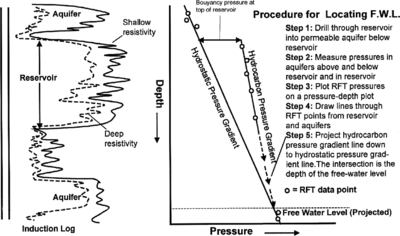Free water level determination using pressure
The free water level occurs where buoyancy pressure is zero in the reservoir-aquifer system. It defines the downdip limits of an accumulation. Pressure data reliability affects the resolution; however, resolution improves when it is supplemented with other petrophysical information.
Procedure: using repeat formation tester (RFT) data[edit]
An easy method for determining free water level (FWL) is projecting RFT pressure data downward from a reservoir to the aquifer. Figure 1 illustrates the procedure.
Procedure using a single measurement[edit]
The list below outlines the procedure for determining the free water level using a single pressure buildup point in the reservoir.
- Determine buoyancy pressure (Pb ) at the depth of the measured pressure (Pm ) from the measured pressure:
- Determine buoyancy pressure gradient (Pbg ):
- Calculate downdip length of hydrocarbon column (h):
As an example, let's determine the downdip length of a 30°API oil column with the following givens:
- Pm = pressure::3555 psi at depth::7611 ft
- Phydrostatic = 3525 psi
- Phydrostatic pressure gradient = 0.465 psi/ft
- Phydrocarbon pressure gradient = 0.38 psi/ft
Answer (tied back to steps above):
Therefore, the free water level is at depth::8167 ft.
See also[edit]
- Static hydrocarbon pressure gradients
- Estimating static oil pressure gradients
- Estimating static gas pressure gradients
- Plotting the hydrocarbon pressure gradient






